Are you a Quiet Speculation member?
If not, now is a perfect time to join up! Our powerful tools, breaking-news analysis, and exclusive Discord channel will make sure you stay up to date and ahead of the curve.
Instant/sorcery support? Cost-reduction mechanics? Cheap card draw for aggressive strategies? Light Up the Stage, a card with spectacle spoiled from Ravnica Allegiance this week, hits all my soft spots, yanking me from a haze of Inkling up-smashes and Richter side-specials to brew anew.
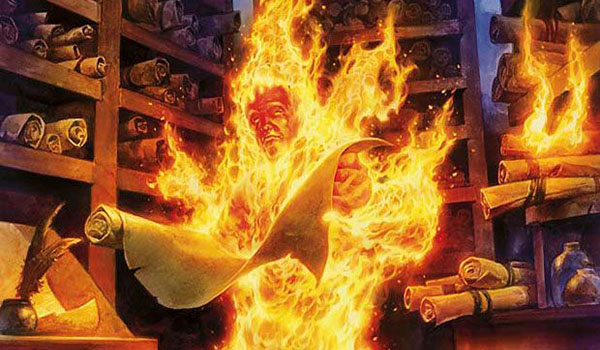
Today, I'll share my findings on Light Up the Stage in what I consider a natural home: Hollow Phoenix.
"Random" Looting Effects Are Not Random
A major complaint of Hollow One newcomers is the deck's randomness. Sometimes that turn-one Inquiry yields a couple Ones and an automatic victory; others, it discards the Golems and mana-screws its pilot! Before we jump into a whole article dealing with Hollow One, I want to give my two cents on this idea.
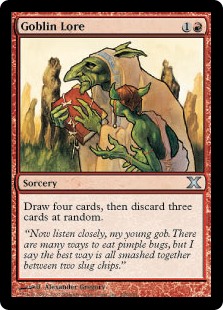 "Random," like all descriptors, can only exist in relation to its environment. And the opposite of random is consistent. So where does Hollow One sit on the random-consistent spectrum? Despite the literal presence of the word "random" in the rules text of archetype staples Burning Inquiry and Goblin Lore, I'd argue that the strategy is among Modern's most consistent, or least random, gameplans—and that its success in the format supports this theorem.
"Random," like all descriptors, can only exist in relation to its environment. And the opposite of random is consistent. So where does Hollow One sit on the random-consistent spectrum? Despite the literal presence of the word "random" in the rules text of archetype staples Burning Inquiry and Goblin Lore, I'd argue that the strategy is among Modern's most consistent, or least random, gameplans—and that its success in the format supports this theorem.
Burning Inquiry (and Lore) has many more subtle effects in Hollow One than its rules text alludes to alone. That text reads: "draw 3 (random) cards; discard 3 random cards." The cards Inquiry draws and discards vary wildly between resolutions—random! But in Hollow One, the card also has the following effects:
- Reduce the cost of all your Hollow Ones to 0
- Give your prowess creatures +1/+1
- Give your Flameblade Adepts +3/+0
The above three clauses are guaranteed (read: not random) effects of Burning Inquiry. On top of all those effects, Inquiry has the added potential benefit of discarding Arclight Phoenix or Fiery Temper, yielding even more explosive plays. And should BR
Hollow One discard its Golem, it's likely to have Gurmag Angler as a backup plan, just as Mono-Red keeps Bedlam Reveler on call.
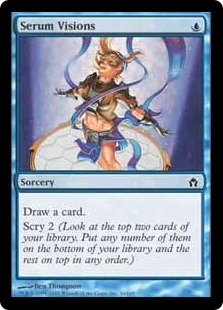 Finally, there's the age-old tactic of sandbagging useless lands in hand until a looting effect is found. Since the pilot chooses when to cast these spells, they can be timed so that probability dictates a net hand improvement.
Finally, there's the age-old tactic of sandbagging useless lands in hand until a looting effect is found. Since the pilot chooses when to cast these spells, they can be timed so that probability dictates a net hand improvement.
Compared with something like Serum Visions, which always draws one card and scries 2, Burning Inquiry in Hollow One decks removes significantly more variance by enabling multiple gameplans. Just as creatureless control decks are built to functionally remove the symmetry of sweepers like Wrath of God, Hollow One decks are built in such a way that random looting effects drastically increase their consistency, in turn lowering their "randomness."
Light Up the Stage
At a glance, Light Up the Stage seems like a card that wants to slot into an aggressive red deck, where it would keep the cards flowing and the pressure on. But it still needs to fulfill needed roles for those decks. The bar is quite high, as Arclight Phoenix strategies are already among Modern's top performers. The other aggressive red deck is Burn, which is generally less proactive and easier to hate out than the Arclight decks, and whose own performance has subsequently taken a dip. We'll start there.
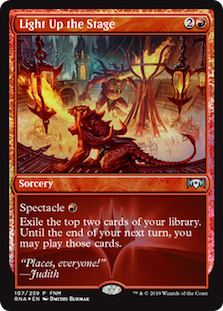 Stage in Burn
Stage in Burn
Burn was happy to go as far as splashing another color for Treasure Cruise, an obvious precedent for Stage. Cruise costs one mana and draws three cards on the condition pilots keep a stocked graveyard. Stage, for its part, costs one mana and draws two cards on the condition pilots have already dealt
damage this turn and can use the cards drawn by the end of their next turn. In terms of raw numbers, that's one fewer card with one more condition attached. But the latter condition isn't so tough to meet, as Burn is full of one
drops. Stage's primary drawback—its spectacle condition—boasts some palpable tension with Burn's haste creatures, which incentivize players to cast draw spells before combat.
Stage has another precedent: Bedlam Reveler. Here's a card that also draws 3 and was discussed as possible in Burn. It costs twice as much mana as Cruise, but players get a whopping 3/4 prowess for their trouble, and multiple Revelers are easier to chain than multiple Cruises. While Reveler did appear in Burn sideboards occasionally, it quickly vanished from the archetype's repertoire, to be seen again beside Faithless Looting in midrange decks a year later.
When it comes to Burn, then, Stage may be adopted if its power level there sits between Cruise (good enough) and Reveler (not). But like both cards, it's fully possible a shell exists that can wield Stage more adeptly than Burn. I think that shell is Hollow Phoenix.
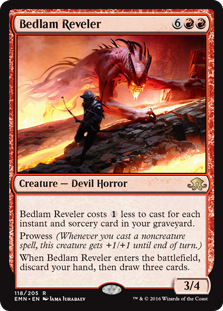 Stage in Phoenix
Stage in Phoenix
Stage looks to be even more comfortable in a deck with Arclight Phoenix: not only does it constitute an instant/sorcery for the creature's trigger, it draws pilots into additional spells and contributes to the deck's velocity. The question to ask, then, becomes whether Arclight Phoenix is interested in drawing more cards; it already has a more impactful option in Bedlam Reveler, which many builds don't even play.
I'd argue that these decks aren't particularly hungry for another draw spell. But more velocity couldn't hurt; we've seen various builds include the likes of Street Wraith, Goblin Lore, and the aptly named Maximize Velocity to achieve those ends. At its best, Stage plays like a mix of Phoenix's most efficient velocity spells: Faithless Looting and Manamorphose. It draws into business like the former, and ensures multiples instant/sorcery casts like the latter.
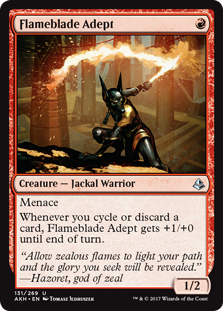 Running Stage isn't totally free, though; doing so requires some deckbuilding compromises to accommodate spectacle reliably. The direction I took involved maxing out on aggressive one-drops. These creatures start swinging out of the gate: Flameblade Adept has menace, ensuring a poke should it survive, and Monastery Swiftspear hits the turn it's cast to set up spectacle on the go. Both creatures hit like a ton of bricks for their cost, assuming a deck construction that keeps both in mind.
Running Stage isn't totally free, though; doing so requires some deckbuilding compromises to accommodate spectacle reliably. The direction I took involved maxing out on aggressive one-drops. These creatures start swinging out of the gate: Flameblade Adept has menace, ensuring a poke should it survive, and Monastery Swiftspear hits the turn it's cast to set up spectacle on the go. Both creatures hit like a ton of bricks for their cost, assuming a deck construction that keeps both in mind.
While a slew of cheap red spells do a fine job of maximizing Swiftspear, Adept demands a more unique supporting cast, notably Burning Inquiry and Hollow One. The artifact also has some interesting applications with Stage: exiling it to the sorcery lets us Burning Inquiry to our heart's content without fear of discarding our namesake creature, and exiling lands lets us play those, keeping Mountains in hand to lower the chances of discarding freshly-found Hollow Ones.
The rest of the deck's first draft wrote itself, and a week of tweaking the components led me here:
Hollow Phoenix, by Jordan Boisvert
Card Choices and Engine Possibilities
This deck's numbers may look simple and intuitive, but arriving at them proved anything but. The flex spots were, and are still, in constant flux throughout my testing sessions. I think there are three types of cards in Hollow Phoenix: enablers, payoffs, and disruption. In this section, we'll look at the different roles each card plays, as well as other options in each category.
As may become evident from my card choices, the above build aims to maximize its explosive starts, and the odds of its pieces meshing in the first few turns of the game. It hopes this strong start will carry it through a potentially meandering mid-game in which ill-fitting pieces are drawn naturally, although cards like Faithless Looting mitigate the durdle.
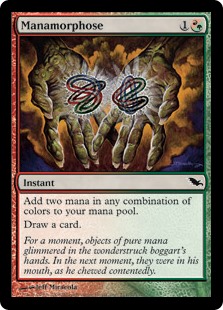 Enablers
Enablers
Let's start with the staples. These are cards whose numbers never faltered in my testing:
4 Faithless Looting
4 Burning Inquiry
4 Manamorphose
Manamorphose practically guarantees a Phoenix rebirth on three mana, is free off Stage, and triggers prowess. Looting is also likely to reanimate Phoenix, digs through excess lands, and further supports our payoffs by dumping Phoenix or Temper into the graveyard. Inquiry is simply the most efficient enabler in Modern when it comes to Hollow and Adept, both four-ofs, and has the random upside of sometimes ruining enemy hands and binning the right payoffs on our end.
Onto the flex spots:
3 Light Up the Stage
3 Gut Shot
I ended up settling on 3 Stage after doing roughly 70% of my testing at 4. Towards the end, I realized Stage excelled when cast on turn three and later. Waiting this long gives us the chance to hard-cast exiled Phoenixes. By turn three, we also have the ability to cast three spells for Phoenix without a zero-mana instant. A sequence like Bolt you, Stage, Looting discarding Phoenix is par for the course at that point in the game.
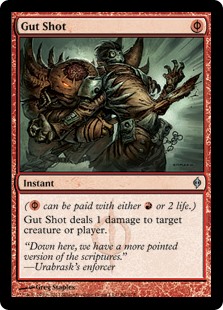 Running Stage out early is possible when we're in need of lands, which can also be played from exile. But relying too heavily on the cantrip for this purpose can yield some awkward exiles forever lost to mana screw, so it's best to wait when given the option. That makes the card closer to Bedlam Reveler, another late-game payoff spell, but Stage has the distinction of serving as an enabler for many of our pieces (including Reveler) in the early- and mid-game.
Running Stage out early is possible when we're in need of lands, which can also be played from exile. But relying too heavily on the cantrip for this purpose can yield some awkward exiles forever lost to mana screw, so it's best to wait when given the option. That makes the card closer to Bedlam Reveler, another late-game payoff spell, but Stage has the distinction of serving as an enabler for many of our pieces (including Reveler) in the early- and mid-game.
While Stage does a fine Manamorphose impression for Phoenix on turns 3+, Gut Shot fills in for Manamorphose when it most needs to: earlier. Another free instant, Gut proves integral to powering out Phoenix before opponents can muster the tools to deal with our assault or assemble a functioning gameplan through our many burn spells. It also supports both "halves" of Light Up a Stage: Gut lets us cast it as early as the first turn to search for lands, and is an always-castable exile off the sorcery.
I also tested plenty of enablers that didn't work out. Here's a quick summary of each.
- Maximize Velocity: Did too little at too steep a cost. Taxing us a red mana per cast doesn't "ramp" us into Phoenix as zero-mana instants do, and since we tend to rely on the discard to play Hollow One, it rarely gives the 4/4 haste. Besides, eight of our threats already have the evergreen keyword.
- Flame Jab: I liked the idea of reliable damage to turn on Stage, but in practice, Jab also did too little. Since early Stages like to find us lands, and late Stages are even fine at three mana, discarding a land rather than a card we wanted to pitch was also a tough ask.
- Lightning Axe: Dead against too many decks to be worth it over a burn spell that fulfills more of our needed functions.
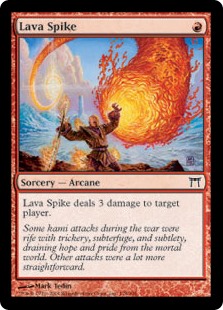 Lava Spike: Probably optimal in a build without Hollow One. Alongside the Golem and its engine cards, Spike has too much tension. I do expect such a build, which blends the Phoenix and Burn cores, to emerge post-Stage; I'm just not so interested in playing it myself.
Lava Spike: Probably optimal in a build without Hollow One. Alongside the Golem and its engine cards, Spike has too much tension. I do expect such a build, which blends the Phoenix and Burn cores, to emerge post-Stage; I'm just not so interested in playing it myself.- Rift Bolt: Similar issues, but also too cute. Suspending it turn one, burning on upkeep, and then casting Stage in main 1 is about as fun as exiling Rift to Stage is miserable.
- Pyretic Ritual: Like Spike and Rift, Ritual belongs in a different build than mine—one perhaps more combo-oriented and featuring Runaway Steam-Kin.
- Street Wraith: Great with One, and we can support the life loss, but can't be cast off Stage.
- Goblin Lore: The best of the reject enablers, Lore sets up Hollow and Adept without the minus or chance of fixing enemy hands. But it's so expensive that reviving Phoenix off it is impossible on three lands without one free spell, and impossible on two lands without double that. Lore is then best run with Gut Shot, but including both packages takes up too much room.
Payoffs
Again, the good:
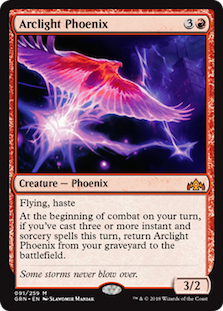 4 Monastery Swiftspear
4 Monastery Swiftspear
4 Flameblade Adept
4 Arclight Phoenix
4 Hollow One
This deck's main payoffs are its threats. It runs eight "Delvers" (aggressive one-drops that put opponents on the back foot), which also enable Light Up the Stage as Wild Nacatl once did Chart a Course, and eight "Goyfs" (bigger beaters meant to clean up the mess and close out games). Of course, its gameplan is far more proactive than that of an actual Delver of Secrets // Delver of Secrets deck.
The ugly...
1 Grim Lavamancer
1 Bedlam Reveler
3 Fiery Temper
With all the one-drops, we don't have room for many flex payoffs in this deck. I tried varying numbers of Lavamancer and Reveler, at times only running one or the other, and eventually settled on a split. The second copy of each is sometimes superfluous, and both offer free win dimensions against certain decks (the former vs. small creatures and the latter against classical midrange). I found that running either Lavamancer or Reveler at 3 or 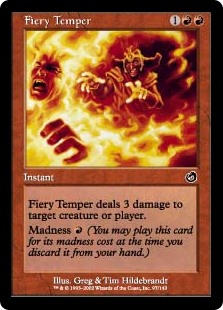 more copies necessitated an 18th land, which I oppose in this explosiveness-aligned build. Reveler in particular has some light tension with Stage in the early-game, where it's a dead exile like Phoenix.
more copies necessitated an 18th land, which I oppose in this explosiveness-aligned build. Reveler in particular has some light tension with Stage in the early-game, where it's a dead exile like Phoenix.
Like the one-drops, Temper is a payoff that doesn't utilize the graveyard, but still rewards our loot effects. I especially like its applications with Phoenix, as it serves as another spell without putting us down a card (yet another thing Manamorphose does for free). More burn lets us attack from multiple angles and turns on spectacle in a pinch, but casting Temper from exile (er, not from madness) is a hassle.
Although Burning Inquiry can occasionally disrupt opponents, it might also fix their hand, and savvy opponents navigate the mid-game with it in mind by also sandbagging useless cards. So I don't really count it as interaction.
The bad!
- Risk Factor: Three mana? thank u, next
- Runaway Steam-Kin: Not bad per se, and a 4-of, then 3-of in my very first Light Up a Stage brew. I quickly learned I had no interest in ever casting this thing and walked away. (But imagine the Gut Shot wars!) To its credit, Risk Factor seemed decent alongside Steam-Kin.
Disruption
Most of our disruption is incidental, as the cards play other, more important roles. We're slower than pure combo decks like Storm, so it's critical that Hollow Phoenix runs enablers and payoffs that disrupt opponents in addition to supporting its gameplan (I like 10+ disruption slots).
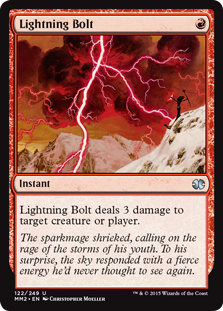 4 Lightning Bolt
4 Lightning Bolt
1 Grim Lavamancer
3 Fiery Temper
3 Gut Shot
The possible exception (and one card on this list we haven't yet discussed in detail) is Lightning Bolt, which is so efficient and flexible it often does act as an enabler (a cheap spell for Phoenix/prowess), or even as a payoff (drawing it off an Inquiry seals many a game), without offering any explicit synergy.
The Stage Is Set
I've been wildly off-base about spoilers before, but never have those cards been so apparently tailor-made for existing tier decks. So where does Hollow Phoenix go from here? Does it want the 4/4 at all? Are Phoenix decks better off pursuing a burn route with Lava Spike? A ritual route with Runaway Steam-Kin? Let me know your thoughts in the comments, and keep watching those Rakdos spoilers—if history has taught us anything, it's that freshly-designed cost-reduction mechanics often find a home in Modern!




I have played Mono-Red Phoenix, similar to the Aaron Sanford build with 17 mountains, but 3 Steam Kin and 2 main deck Blood Moons (often a game winner, but easy enough to loot away if it is a dead draw) and a 2/2 Swiftspear/Soulscar split. The deck does pretty well, went 5-3 at a GP and won a local 32 person tournament. I only play in paper, but it has had a winning record at every event I have entered.
I was excited to see Light Up the Stage and thought it had some real potential. I found this article two weeks ago and built your deck to try it out. In testing it, I feel like I still win more games as a Phoenix deck than a Hollow One deck. I have twice had the perfect golem exile with Burning Inquiry in hand, so it can be cool. I already play with a fair amount of inconsistency, so adding a bit more wasn’t too hard. I also tried just making space for fitting 3 Light Ups into my own deck, and it seems to be a slight improvement. I think your deck is stronger against interactive decks than mine, but weaker against Aggro-combo (though inquiry can mess up some of those combos). Steam Kin is a “test for removal” and if they don’t have removal, it really does run away with the game.
Maybe it was just the matches I played, but I disagreed with mainboarding Lavamancer, and swapped it to the sideboard for the other Reveler. I was always happy to see the Reveler, and often wished the Lavamancer was another one, and I like the deck better with more gas. As frustrating as discarding a Hollow One and keeping a Phoenix is, the opposite is a lot of fun. I will be playing the deck this week (with some differences to the sideboard to accommodate my local meta). Have you given this deck any more consideration in the last few weeks? Anything you found that works a bit better?